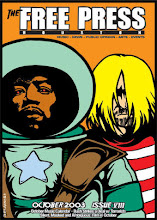Afghanistan: Hidden Treasures

Afghanistan: Hidden Treasures from the National Museum Kabul, presently on exhibit at the Museum of Fine Arts, Houston until May 17, asks a disturbing question. What happens when governments rewrite history by destroying history?
When the Taliban blew up the largest statues in the world in March of 2001, the Buddhas of Bamyan, were they obliterating them because they depicted deity in human form? Many of the items in the exhibit, a lot of them the size of your small fingernail, depict gods like Athena or Eros who's holding his wife Psyche depicted as a butterfly (below pic).
I'm no historian but on a timeline of the last 30 years, in 1978 the Russians took over Afghanistan at roughly the same time archaeologist Viktor Sarianidi discovered a horde of gold objects 2000 years old.
Nobody ever stays, whether it's the Russians, British or Genghis Khan - Forget it Jake, it's Afghanistan. The over 20,000 items were transferred to the museum in Kabul where they were achieved. When the Russians left in 1988 the country was caught between the Taliban, the Mujahadeem and Civil War. Somewhere along the line the contents of the Sarianidi find disappeared from the museum, which was thought destroyed when the museum was bombed. Speaking before a group of media before the opening, Omara Khan Masoudi, Director of the National Museum of Afghanistan, expressed his astonishment that the Taliban, who took control of the country in 1996, waited so long to destroy the statues. "Nobody knows who gave the order to destroy those stateues," he said,
Also looted or demolished were many artifacts of the Kabul museum, itself an impressive palace with classical architecture. And now these tiny trinkets of gold, most displayed in hermetically sealed cases, are on a four city North American tour to fascinate the imagination. The Indian themed circle on the brow of a cherub Athena combined with Greco-Roman wings and ornamentation shows that the Silk Route through Afghanistan two millennia ago was a sophisticated Route 66 that connected the Middle East with Central Asia and India.

As I was glancing down through the glass case onto a series of gold rings, I noticed that the spelling of Athena was backwards because the item was a stamp (see pic, the alphabet is Cyrillic). The detail is amazing, especially considering how small the lucky charms are. A crown, which is one of the show's centerpieces, has six small rod-like trees that are removed and the crown folds up for easy travel. Because of the long distance of travel involved on the Silk Route the preferred means of exchange could best be carried as tight packets of gold.
The gallery display includes items from the first and second century found at sites in Northern Afghanistan, in the Begram and Tillya Tepe regions, as well as a 28-minute National Geographic documentary narrated by Khaled Hosseini (Kite Runner) describing how the treasures were found in locked safes in 2003.









0 Comments:
Post a Comment
<< Home